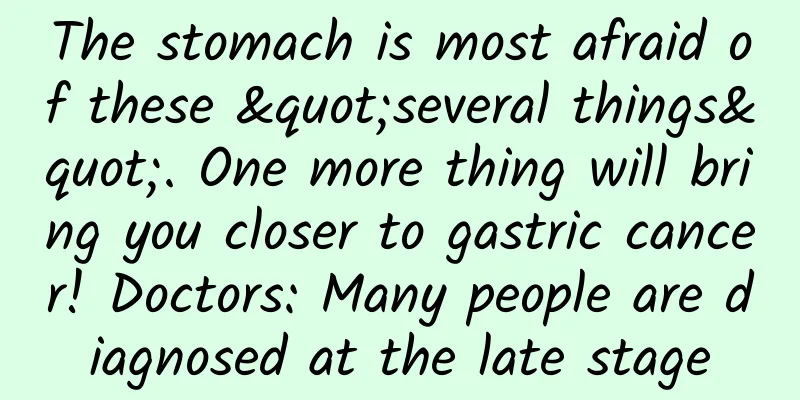The stomach is most afraid of these "several things". One more thing will bring you closer to gastric cancer! Doctors: Many people are diagnosed at the late stage

|
Expert of this article: Hu Zhongdong, chief physician of the Health Management Center of Changsha Third Hospital, deputy chief physician, member of the Youth Science Popularization Innovation Professional Committee of Hunan Medical Education and Technology Association When it comes to stomach problems, people generally believe that "it's a small matter and it will go away if you endure it." According to reports, a 24-year-old graduate student from a university in Nanjing began to frequently feel stomach discomfort since July last year. After searching online, she thought it was "gastric ulcer". Every time she felt stomach discomfort, she took medicine to relieve it. Recently, she went to the doctor after experiencing severe abdominal distension and was diagnosed with "late-stage gastric cancer with abdominal metastasis", and it was a highly malignant gastric signet ring cell carcinoma. News screenshots According to the latest data from my country in 2020, the incidence and mortality of gastric cancer ranked third among all malignant tumors. There are about 1.2 million new cases of gastric cancer each year in the world, of which my country accounts for about 40%. The proportion of early gastric cancer in my country is very low, only about 20%, and most of them are already in the advanced stage when they are discovered, with an overall 5-year survival rate of less than 50%. How to prevent stomach cancer? What are the things to do to keep your stomach healthy? Let's learn about it together... What is gastric signet ring cell carcinoma? Gastric cancer is a malignant tumor originating from gastric mucosal epithelial cells and can occur in various parts of the stomach. The most common type in my country is gastric adenocarcinoma. It is one of the most common digestive tract tumors and seriously threatens people's life and health. Gastric signet ring cell carcinoma is highly invasive, rapidly progresses, and is highly malignant. It is more common in young people, with mild early symptoms. The lesions grow diffusely and infiltratively. The growth direction of gastric cancer cells does not protrude into the stomach cavity, but invades outward along the submucosal layer, muscular layer, and serosa, eventually causing the entire stomach wall to become thicker and harder, and the peristalsis of the gastric mucosa disappears. It resembles leather, hence the name "leather stomach." Copyright image, no permission to reprint However, gastric signet ring cell carcinoma is only a histological classification and cannot directly determine the tumor stage. For gastric cancer patients, the severity of the tumor is determined by the depth of tumor infiltration (T stage), the number of lymph node metastases (N stage), and whether there is distant metastasis (M stage). Most patients with early-stage gastric cancer have no obvious symptoms and signs. Some patients may experience indigestion and stomach discomfort, a feeling of fullness after eating, mild nausea, loss of appetite, burning sensation in the stomach, etc. Deep tenderness in the upper abdomen may be the only noticeable sign. How to screen for gastric cancer? Gastric cancer screening mainly includes serological examination (serum pepsinogen (PG), serum gastrin 17 (G-17), serum Hp infection detection) and endoscopic examination. Gastroscopy can directly see the esophagus and gastric mucosa, and can more clearly observe superficial lesions of the mucosa. If suspicious lesions are found under endoscopy, a biopsy is required. If you have a low tolerance for pain, you can consider painless gastroscopy. However, painless gastroscopy has contraindications. Patients who want to make an appointment for painless gastroscopy must first pass the anesthesia evaluation of the anesthesiologist. For example, patients with severe hypertension, cardiovascular and cerebrovascular diseases are not suitable for painless gastroscopy. Copyright image, no permission to reprint Your stomach is most afraid of you doing these things The stomach is afraid that people do not chew slowly, do not quit smoking and limit alcohol consumption, do not reduce salt intake, like pickled, smoked, red and processed meats, often eat spicy, raw and cold foods, and do not eat or eat less fresh vegetables and fruits. Irregular work and rest schedule, staying up late for a long time, suppressing personality and sulking. Failure to promptly treat Helicobacter pylori infection. However, the breath test for detecting Helicobacter pylori cannot replace gastroscopy. Gastroscopy is not that scary, and it should be done! People at high risk of gastric cancer (such as those aged > 40 years, with a history of gastric diseases such as chronic atrophic gastritis, gastric ulcer, gastric polyps, residual stomach after surgery, hypertrophic gastritis, pernicious anemia, a family history of gastric cancer, and Helicobacter pylori (Hp) infection) do not participate in cancer prevention physical examinations and screenings regularly, ignore gastric diseases, and fail to receive timely treatment and regular check-ups. Copyright image, no permission to reprint When the stomach is uncomfortable, especially when taking medicine can not relieve the symptoms, gastroscopy is not done immediately. If the stomach is often uncomfortable, it is important to find out the cause. One gastroscopy may lead to missed diagnosis, and another gastroscopy should be done if necessary. The timing of gastric cancer detection directly determines the patient's survival rate. The 5-year survival rate of early gastric cancer is over 90%, while the 5-year survival rate of mid- to late-stage gastric cancer is only 20% to 30%. Screening is conducted among high-risk groups for gastric cancer to achieve early detection, early diagnosis, and early treatment. How to nourish your stomach? Eat a light and regular diet, eat on time, have three meals at regular times and in regular amounts, chew meals slowly, and pay attention to keeping your stomach warm and ensuring food hygiene to prevent gastrointestinal diseases. When you have gastrointestinal discomfort, try to eat small meals frequently and do not lie down immediately after eating. Copyright image, no permission to reprint In addition, you can eat some yam, millet, pumpkin and other foods appropriately, which can help nourish the stomach. The watermarked images and cover images in this article are from the copyright gallery, and the image content is not authorized for reprinting |
<<: Popular Science Cartoon | How did cholera spread?
>>: Identification of popular food: milk tea condiments!
Recommend
How can we help our children become more courageous when facing failure?
This article is selected from the Hunzhi comic se...
He just renovated a lighthouse, so why was he awarded the Nobel Prize this year?
In 1912, the Royal Swedish Academy of Sciences de...
18 Practical Marketing Experiences from Advertising Mad Man Ye Maozhong
Are you worried about how to improve your brand a...
IBOutletCollection
IBOutletCollection When connecting IB with relate...
The shortest-lived 3G network: What can we learn from TD-SCDMA?
4G is getting closer and closer, and the three ma...
The nicknames of the Winter Olympics venues are all about Chinese romance!
The "Water Cube" has been transformed i...
Visual Studio 2015 will be released on July 20
[[138348]] Microsoft has announced that the offic...
Metaverse Marketing: 4 Transformations Brands Need to Face!
Since the beginning of this year, the "metav...
The location of Wenchang Tower before the exam
Many parents are very concerned about their child...
Ministry of Public Security: In 2019, the number of private cars in China exceeded 200 million for the first time, and the total number of drivers reached 435 million
According to statistics from the Ministry of Publ...
Android Pay: UnionPay's dream of near-field payment?
Mobile payment has penetrated into our daily life...
How to make a mini program for a clothing store in Guangzhou? How to build a clothing WeChat applet?
The Internet has undergone a development trend in...
"Set a sample first" at your doorstep! Shoufa Group led Baidu Qianfang's vehicle-road collaboration equipment to be first deployed in the northern section of Yanchong Expressway
The northern section of Yanchong Expressway is 11...
Hybrid App Development: Using WebView to Load Pages
Hybrid App is the abbreviation of hybrid mode app...
When seeing a doctor, should you trust Baidu or your doctor?
In an era when Internet search is widely used, sea...









